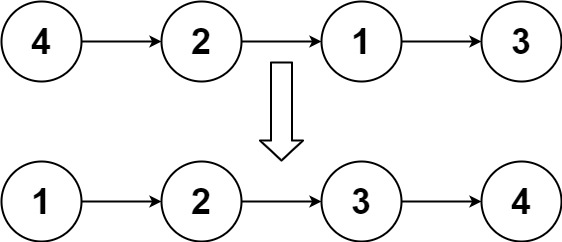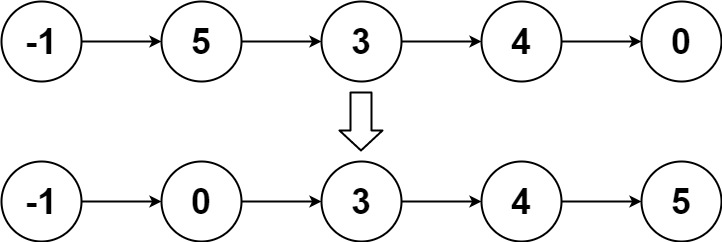【LeetCode热题100道笔记】排序链表
题目描述
给你链表的头结点 head ,请将其按 升序 排列并返回 排序后的链表 。
示例 1:

输入:head = [4,2,1,3]
输出:[1,2,3,4]
示例 2:

输入:head = [-1,5,3,4,0]
输出:[-1,0,3,4,5]
示例 3:
输入:head = []
输出:[]
提示:
链表中节点的数目在范围 [0, 5 * 104] 内
-105 <= Node.val <= 105
进阶:你可以在 O(n log n) 时间复杂度和常数级空间复杂度下,对链表进行排序吗?
思考一:堆排序
- 构建最小堆:遍历链表,将所有节点逐个加入最小堆(存储节点本身,需先断开原节点的next指针避免环)。
- 弹出构建新链表:从堆中依次弹出最小节点,串联成有序链表。
算法过程
- 初始化:创建一个最小堆(按节点值比较)和遍历指针。
- 入堆:遍历链表,每个节点断开next指针后加入堆,确保堆中节点独立。
- 出堆构建:新建哨兵节点,循环弹出堆顶(最小节点)并接入新链表,直至堆空。
- 返回结果:哨兵节点的next即为排序后链表头。
复杂度
- 时间复杂度:O(n log n),入堆和出堆各需O(n log n)。
- 空间复杂度:O(n),堆存储所有节点。
代码
/*** Definition for singly-linked list.* function ListNode(val, next) {* this.val = (val===undefined ? 0 : val)* this.next = (next===undefined ? null : next)* }*/
/*** @param {ListNode} head* @return {ListNode}*/
var sortList = function(head) {const minHeap = new MinHeap((a, b) => a.val - b.val);let p = head;while (p) {let tmp = p.next;p.next = null;minHeap.add(p);p = tmp;}const guard = new ListNode();p = guard;while (!minHeap.isEmpty()) {p.next = minHeap.pop();p = p.next;}return guard.next;
};class MinHeap {constructor(compare) {this._data = [];this._compare = compare;}add(num) {this._data.push(num);this.swim();}pop() {if (this._data.length === 0) return;[this._data[0], this._data[this._data.length-1]] = [this._data[this._data.length-1], this._data[0]];const node = this._data.pop();this.sink();return node;}isEmpty() {return this._data.length === 0;}swim(index = this._data.length-1) {while (index > 0) {let pIndex = Math.floor((index-1)/2);if (this._compare(this._data[index], this._data[pIndex]) < 0) {[this._data[index], this._data[pIndex]] = [this._data[pIndex], this._data[index]];index = pIndex;continue;}break;}}sink(index = 0) {const n = this._data.length;while (true) {let left = 2 * index + 1;let right = left + 1;let biggest = index;if (left < n && this._compare(this._data[left], this._data[index]) < 0) {biggest = left;}if (right < n && this._compare(this._data[right], this._data[biggest]) < 0) {biggest = right;}if (biggest !== index) {[this._data[biggest], this._data[index]] = [this._data[index], this._data[biggest]];index = biggest;continue;}break;}}}思考二:自顶向下归并排序
核心是分治思想:用快慢指针找链表中点,将链表递归拆分为左右两个子链表,直到子链表仅含1个节点(天然有序);再递归合并两个有序子链表,最终得到完整有序链表。
算法过程
-
递归终止条件:
- 若当前链表为空(
head === null),直接返回空; - 若当前链表仅含1个节点(
head.next === tail),断开该节点的next指针(避免后续合并出现环),返回该节点。
- 若当前链表为空(
-
拆分(分):
- 用快慢指针找中点:慢指针(
slow)每次走1步,快指针(fast)每次走2步,当fast到达tail时,slow即为当前链表中点; - 递归拆分左子链表(
head到mid)和右子链表(mid到tail)。
- 用快慢指针找中点:慢指针(
-
合并(治):
- 调用合并函数,将左右两个有序子链表合并为一个新的有序链表;
- 返回合并后的链表头,完成当前层级的递归回溯。
关键辅助:合并有序链表
- 新建哨兵节点(
dummyHead),用指针temp遍历并构建合并链表; - 双指针分别遍历两个有序子链表,每次将值更小的节点接入
temp后; - 遍历结束后,将剩余未接入的子链表节点直接接在
temp尾部; - 返回哨兵节点的
next(即合并后的有序链表头)。
复杂度
- 时间复杂度:O(n log n),拆分需O(log n)层递归,每层合并需O(n)(遍历所有节点)。
- 空间复杂度:O(log n),递归调用栈深度等于拆分层数(即链表高度),最坏为O(n)(链状链表),平均为O(log n)。
代码
/*** Definition for singly-linked list.* function ListNode(val, next) {* this.val = (val===undefined ? 0 : val)* this.next = (next===undefined ? null : next)* }*/
/*** @param {ListNode} head* @return {ListNode}*/
var sortList = function(head) {return toSortList(head, null);
};function toSortList(head, tail) {if (head === null) return head;if (head.next === tail) {head.next = null;return head;}let slow = head, fast = head;while (fast !== tail) {slow = slow.next;fast = fast.next;if (fast !== tail) {fast = fast.next;}}const mid = slow;return merge(toSortList(head, mid), toSortList(mid, tail));
}function merge(head1, head2) {const dummyHead = new ListNode(0);let temp = dummyHead, temp1 = head1, temp2 = head2;while (temp1 !== null && temp2 !== null) {if (temp1.val <= temp2.val) {temp.next = temp1;temp1 = temp1.next;} else {temp.next = temp2;temp2 = temp2.next;}temp = temp.next;}if (temp1 !== null) {temp.next = temp1;} else if (temp2 !== null) {temp.next = temp2;}return dummyHead.next;
}思考三:自底向上实现归并排序
核心是分治思想的迭代实现:无需递归栈,从最小有序单元(单个节点)开始,按“子链表长度翻倍”的规则,逐层合并相邻子链表,最终得到完整有序链表。该方式避免了递归栈开销,实现常数级空间复杂度,满足题目进阶要求。
算法过程
-
预处理:
- 若链表为空,直接返回
null; - 遍历链表统计总长度
length,用于控制合并的终止条件; - 新建哨兵节点
dummyHead,其next指向原链表头,方便后续统一处理链表连接。
- 若链表为空,直接返回
-
迭代合并(子链表长度递进):
- 初始子链表长度
subLen = 1(单个节点天然有序),每次循环后subLen <<= 1(左移1位,即长度翻倍),直到subLen >= length(所有节点合并为一个有序链表); - 每次按当前
subLen处理链表:- 初始化
prev(记录已合并部分的尾节点,初始为dummyHead)和curr(当前待拆分节点,初始为原链表头); - 拆分相邻子链表:
- 拆分左子链表
head1:从curr开始取subLen个节点,curr最终停在head1的尾节点; - 拆分右子链表
head2:从curr.next开始取subLen个节点(若剩余节点不足则取全部),并断开head1与head2、head2与后续节点的连接(避免合并时出现环);
- 拆分左子链表
- 合并子链表:调用
merge函数,将head1和head2合并为有序子链表; - 连接与更新:将合并后的子链表接入
prev尾部,更新prev到当前合并子链表的尾节点,再将curr指向未处理的节点,重复步骤2-4直到遍历完链表。
- 初始化
- 初始子链表长度
-
辅助函数:合并两个有序链表:
- 新建哨兵节点
dummyHead,用temp指针遍历并构建合并链表; - 双指针
temp1、temp2分别遍历head1、head2,每次将值更小的节点接入temp后; - 遍历结束后,将剩余未接入的子链表节点直接接在
temp尾部; - 返回
dummyHead.next(即合并后的有序链表头)。
- 新建哨兵节点
复杂度分析
| 复杂度 | 说明 |
|---|---|
| 时间复杂度 | O(n log n) |
合并轮次:子链表长度从1翻倍到>=n,共需log n轮;每轮操作:遍历所有节点完成合并,总操作次数为 O(n),故总时间为O(n log n)。 | |
| 空间复杂度 | O(1) |
仅用有限个指针(prev、curr、head1、head2等)和哨兵节点,无额外空间消耗,满足题目“常数级空间”的进阶要求。 |
核心优势(对比自顶向下归并)
- 空间更优:避免递归栈的
O(log n)空间开销,仅用常数空间; - 稳定性好:归并排序本身是稳定排序,不会改变相同值节点的相对顺序;
- 适配大规模链表:无需递归深度限制,更适合节点数极多(如题目提示的
5*10^4)的链表场景。
代码
/*** Definition for singly-linked list.* function ListNode(val, next) {* this.val = (val===undefined ? 0 : val)* this.next = (next===undefined ? null : next)* }*/
/*** @param {ListNode} head* @return {ListNode}*/
var sortList = function(head) {if (head === null) return head;let length = 0;let node = head;while (node !== null) {length++;node = node.next;}const dummyHead = new ListNode(0, head);for (let subLen = 1; subLen < length; subLen <<= 1) {let prev = dummyHead, curr = dummyHead.next;while (curr !== null) {let head1 = curr;for (let i = 1; i < subLen && curr.next !== null; i++) {curr = curr.next;}let head2 = curr.next;curr.next = null;curr = head2;for (let i = 1; i < subLen && curr != null && curr.next !== null; i++) {curr = curr.next;}let next = null;if (curr != null) {next = curr.next;curr.next = null;}const merged = merge(head1, head2);prev.next = merged;while (prev.next !== null) {prev = prev.next;}curr = next;}}return dummyHead.next;
};function merge(head1, head2) {const dummyHead = new ListNode(0);let temp = dummyHead, temp1 = head1, temp2 = head2;while (temp1 !== null && temp2 !== null) {if (temp1.val <= temp2.val) {temp.next = temp1;temp1 = temp1.next;} else {temp.next = temp2;temp2 = temp2.next;}temp = temp.next;}if (temp1 !== null) {temp.next = temp1;} else if (temp2 !== null) {temp.next = temp2;}return dummyHead.next;
}